Reverse Rotors
Unreasonable Men: Precession, Gyroscopes
and Reverse Rotating Front Rotors
This is a story about a man that not only ponders but, laudably, acts. In 2000 Robert Kasten (then 32 years old) bought a 1996 Honda CBR 600 F3. Having owned dirt bikes as a kid growing up in Fontana California, he found that street riding was quite a bit different than the dirt. A friend following him on his first street ride observed that Robert seemed to be struggling a bit with the handling of the bike and that, perhaps, it was because he was not counter steering the bike.
At first Robert thought his friend was pulling his leg since it is counter intuitive to turn the bars away from the direction in which you want to go and, despite finding that counter steering did, in fact, make his F3 much more manageable, Robert was extremely dissatisfied with the explanation of the functional mechanics of counter steering.
Robert, you see, studied Religion and Philosophy in college. These are not two disciplines of academia where one ventures unless one has retained the insistent curiosity of the five year old that many of us lose to the distractions of the post-industrial society or other struggles of survival. That is the characteristic of asking “Why?” to every question.
Unable to find the answer to counter steering in the ethereal canons of religion and philosophy, Kasten turned to the ultimate discipline of the “Why”: physics.
There are undeniably many dynamics of motorcycle handling which have been documented and explained, both erroneously and correctly, in pubs, rest stops, articles, books and Internet BBS’s. Reduced to its simplest form, two wheeled vehicles can be examined as a bicycle.
The first thing a physicist would find notable about a bicycle is that it has two enormous gyroscopes at the front and rear of the vehicle. Gyroscopes have many interesting characteristic but the one in which many a wobbling bicycle racer on a fast descent may be interested would be that gyroscopes react to turning inputs in a predictable manner. Spin a bicycle wheel away from you while holding it in your hands held straight out from your body. Turn the axle, parallel to the floor, to the right. The wheel will torque down and to the left. Read the last two sentences again. A gyroscope will always react to input 90 degrees in the opposite direction. This is called “precession.”
As you try to correct the spin of that bicycle wheel you will find that the precession is constantly working against your efforts to hold the wheel straight and instead you will end up (if the wheel continues to spin) with a wildly wobbling gyroscope in your hands.
The second thing a physicist might notice about a bicycle (assuming they didn’t take physics after lunch in high school and, therefore, nap a little during certain explanations) is that (assuming they did well in geometry as opposed to being called “an intellectual dilettante” by their geometry teacher) there are two interesting numbers related to the front wheel and the top of the fork. These are rake and trail. Simply put: rake is the angle of the steering stem from vertical and trail is the distance between the center of the contact patch (defined by the center of the axle) of the tire and where a line drawn from the steering stem to the ground would make a point.
When a front bicycle wheel is out of line the contact patch is off to one side or another of the point on the ground defined by the steering stem. The more trail in the geometry the greater that offset will be for a given degree of turn. The greater the offset the more torque is created to pull the contact patch back into line with the steering stem and, therefore, the greater the amount of either stability (in a good sense) or under steer (in a bad sense). The trade off with trail is, therefore, stability (and that can be stability and feel when going through a fifth gear down hill turn, not just in a straight line) versus slow handling.
Kasten postulated that three of the widely circulated axioms of motorcycle handling were, in fact, myths. He countered with these assertions:
1. Motorcycles are not given stability by the gyroscopic action of the wheels but are
destabilized by the front wheel’s constant precession-induced corrections and
oscillations.
2. Motorcycles do not stay upright due to the gyroscopes of the wheels. They stay
upright by constantly balancing forward motion against gravity. Ice stakes do not
have gyroscopes.
3. Trail provides correcting force for under steer on a motorcycle, not gyroscopic
precession.
In order to test the theory that gyroscopic precession is only detrimental to motorcycle handling, one would either need a front wheel, brakes and tire of no mass or one would need to devise a system where the forces created by the spinning wheel and tire were canceled out by a gyroscope of equal power spinning in the other direction.
Since wheels and tires of no mass are of limited availability, Kasten devised a simple sequence of sun and planet gears which ultimately spin the brake rotors in the opposite direction of the rotation of the front wheel. The wheel and tire are bigger and heavier than the brake rotors so the gears are sized to spin the rotors 2.7 times faster than the RPM of the wheel. On Kasten’s prototype he has not canceled out the wheel gyroscope completely but has reduced it by about 80%.
In 2003 Kasten hired a patent attorney and filed papers and in 2005 he was granted the patent for reverse rotating brake rotors. Apparently Aermacchi tried a similar set up in the sixties but never followed through with patent work.
In August of 2006 I met Kasten at JenningsGP racetrack to test his invention. Kasten is financing the construction, the legal work and the design out of his salary from selling cars which put severe constraints on luxury pit accommodations, fancy new motorcycles or, evidently, new tires for a track day.
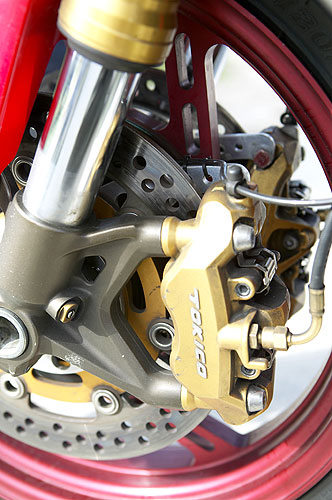
From a distance this almost looks stock until you realize that
the wheel is carved from a forging, the hub is huge and there
are these torque plates attached to the backs of the brake calipers.
The test platform was a 2003 ZX-636. Although not in bad
condition overall it was not exactly a stellar example of the
breed. I spent a few minutes looking over the bike as the idea
of throwing myself down on the pavement, painful though
that might be, might mean scratching my Scott McDermott
helmet and leathers.

It might not look like much here but it stops everyone in
the pits when it rolls forward and the rotors rotate backwards.
The rebound dampers were too slow and the ride height lock nut was loose. Once those were corrected I was looking at a bike that was set up profoundly on its nose with the forks dropped and the rear raised substantially. The Dunlops had already served duty for one track day and were a relaxing shade of blue. Conspicuous in its absence was the steering damper. Looking at the bike I expected it to be a wobbling unstable beast.
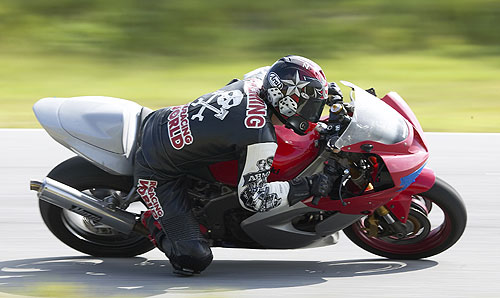
Balancing inertia, velocity, gravity, and the precession of a wide variety of gyroscopes.
JenningsGP has a couple of ultra fast left hand turns leading into a switchback style series of turns. A perfectly well handling machine tends to get tied in knots going through that last left (wobbling) and then requires a huge amount of effort to make the fast left right transition through the next turns.
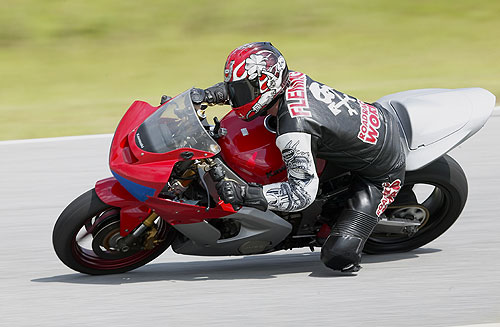
One of the most free thinking experimental revisions to motorcycle handling
in the last thirty years but with blue tape over the headlights.
Kasten took it out for a session to check it out and turned it over to me but it was not without some trepidation that rolled it out onto the track.
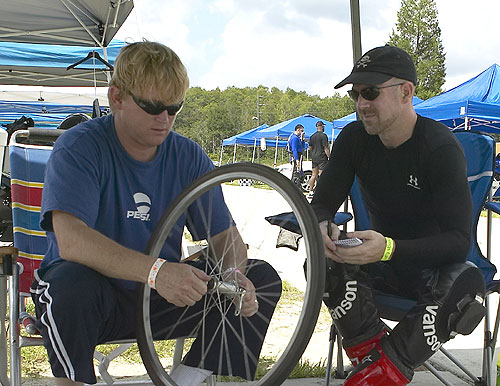
Robert Kasten performs experiments in gyroscopic precession for Fleming.
The first thing that I noticed is that when you spin the brake rotors 2.7 times faster than the wheel, the brakes become much more powerful. Although the ultimate force dissipated as heat by the brake system will be the same as with a conventional wheel, the lever effort required by this set up was about half or less than what is ordinarily required. Good four piston brake calipers have differential bore slave cylinders because the pads are dragged into the rotor as they grip. This bike had phenomenal brake response with a stock master cylinder, old race spec brake pads and with calipers that are optimized for brake rotors spinning the other way. The brakes were a little much at first but once I learned to only put one finger on the lever I became more comfortable trail braking deep into some of the corners. The brake calipers were also not in the best shape resulting in some drag on the rotors. This drag is then multiplied by 2.7 so something which is just mildly annoying on a normal race bike became much more discernable on this one.

“Gyroscopic precession of the front wheel does absolutely nothing except
make the bike wobble and hard to turn.” – Robert Kasten tests his creation.
The second thing I noticed is that the prototype gear set and rotors are pretty heavy. Now, I understand how difficult it is to build anything and I also understand the value of building proof-of-concept prototypes so I am not going to put much emphasis on this point. This set up added about ten pounds of un-sprung mass to the front wheel.
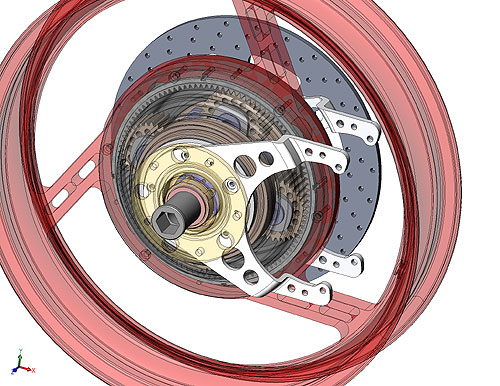
"A reasonable man adapts himself to his environment. An unreasonable man persists
in attempting to adapt his environment to suit himself. Therefore, all
progress depends on the unreasonable man." — George Bernard Shaw
Sprung weight is comprised of any part of the bike that sits on top of the springs (fork and shock). Un-sprung weight is made up of any parts of the bike that sit below the springs (tires, wheels, brakes, rotors, fork tubes, swingarm, etc). Un-sprung weight acts a little like the head of a hammer pounding at the rest of the chassis. A heavy front wheel, upon contact with a bump, is going to hit the chassis a lot harder than a light front wheel. One unfortunate dynamic of modern supersport race bike preparation is that we tend to remove sprung weight (exhaust, bodywork etc) but can’t decrease un-sprung weight so the ratio of sprung to un-sprung weight actually get worse with most race bikes.
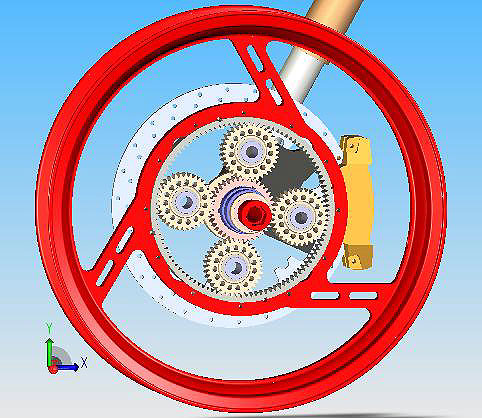
Rim rotates forwards driving the four planet gears backwards.
Rotors are connected to the planet gears.
Kasten is confident that he can get the weight penalty down to about one pound in a production model. The prototype is overbuilt and has redundant components that could be eliminated in a production version. However, on this day on this track the un-sprung weight of the front wheel was noticeable in the bike’s sensitivity to bumps, particularly at low speeds. It was not chattering, it was magnifying the bumps on the track by a factor of two or three. Fortunately the JenningsGP track only has bumps in a couple of the turns.
After coming to grips with the amplified brakes and the bump response I began to step up the pace into the four fast lefts of Jennings’ back straight. With the extreme rake and trail set up on the bike, and the absence of a steering damper, I was trepidacious about stepping up the pace since I fully expected the bike to go into an unrecoverable tank slapper going through the fifth gear sweeper. However, no matter how hard I drove through the lefts the bike remained stable and responsive.
Eventually I was giving it the full race throttle-pinned-catching-speed-shifts-pass-two-bikes-pull-back-onto-the-race-line-no-brakes-catch-a-downshift-and-flick-hard-left-hard-right treatment. The bike remained absolutely stable through out it all. No weave, no wobble, no drama. And this was not on a well set-up race bike. This was on an okay set-up track day bike with no steering damper. Not only was the bike handling all the high speed turns without wobbling (something I cannot say for any of the GSX-R race bikes I have ridden at JenningsGP, including the 600 with which we won a National Endurance race overall) but I noticed that my forearms were not getting pumped or tired from the effort. All of the gyroscopic precession dynamics of the front wheel have to be contained by the rider’s forearms (or the steering damper) and the oscillation of precession is omnipresent on a racetrack. Anytime the rider changes lean angle or hits a bump the wheel’s gyroscope is thrown out of kilter and the rider must correct to get it back. Most of the time this is very subtle but I felt that with the removal of most of the precession my arms were only handling the strains of steering and braking and could relax more on the rest of the lap.
The bike was stable (when I don’t believe it would have been with a stock wheel and rotors) but it still required an almost normal amount of effort to force it to switch from one extreme lean angle to the other side. This is to be expected because one is still wrestling a large heavy thing with lots of inertia and, of course, there is still the gyroscopic effect of the crankshaft that affects handling as well.
Kasten has very well thought out reasoning about why the gyroscopic effect of the crankshaft has no perceptible effect on steering. He has a much greater grounding in physics to make his argument that the spinning crank weight has no perceptible effect on steering (he takes great exception to Czysz’s claims of improved handling through counter rotating cranks) but in single blind tests I have always been able to pick the bike with the heavier crank, even when initially told that two bikes had the same crank when literally every other component on the bikes was identical. I would not be able to explain the math of it, only that my personal experience goes against his contention of the irrelevance of crankshafts on handling.
The mechanism that reverses the rotation of the rotors is pretty simple. A large outer gear is bolted to the inside of the hub of the wheel. This gear, when rotating forward, drives a set of four planet gears in the opposite direction. The planet gears are held in place by a plate attached by a torque arm to brake rotors. This forces the planet gears to turn a single sun gear in the opposite direction of rotation from the wheel. The rotors are attached to the sun gear which reverses their direction of rotation. Depending on the relative sizes of the gears the rotors can be spun at different speeds to create a different level of gyroscopic cancellation. The entire assembly is sealed and lubricated with automatic transmission fluid. There is a small breather on the top to keep the case from becoming pressurized with changes in temperature.
Running the applicable usage of this invention to its logical conclusion I end up with a couple of conclusions. For street riding there would be little or no utility with this handling change. This is because street riding is so slow and lethargic that the improvement in high speed dynamic steering would really only be felt the instant before the intrepid rider was killed by hitting a deer, a car, slipping on diesel or tagging a coal truck. This, of course, has not seemed to slow down the sale of various motorcycles which are complete and utter over kill (see: anything with a model name with an “R” in it) so, just because it won’t actually improve the experience at a noticeable level many riders may want such a thing for the same reason they spend $1,300 for a loud pipe that weighs slightly less than the stock one. In other words, just because it is not going to help most riders get to work or navigate their favorite stretch of back road does not mean that they would not buy this as an aftermarket product. It is not like the owners of R1-LE actually get anywhere faster than the owners of R1s when riding around the city but all of those sold pretty quickly so maybe there are crowds of velcro vested weekend sportbikers and lavishly modified track day riders who are ready to spend $2,500 to spin their rotors backwards.
Racing, of course, is a whole different deal. Unless fitted to an OEM bike this would not be legal for any sort of US class that does not allow fitment of alternate wheels or brakes. That is virtually every money paying class in the country.
Superbike rules were not written with such an invention in mind so I believe that, unless they are revised very quickly, such a modification would be legal for Superbike based classes. The market of superbike owners gets to be pretty small but it is slightly larger than the ownership pool of purpose-built formula one machines. Of course, someone is buying all those aftermarket magnesium and carbon wheels or, presumably, those various companies would stop making them.
In MotoGP the brake rotors are featherweight, the wheels are very light but the tires are still race tires. In my mind that means those carbon rotors would have to be spun at absurd speeds to be able to counteract the precession created by the weight of the tire. In other words, the ratio of rotor weight to wheel/tire weight is very different on a GP bike than on a superbike (using iron or steel rotors) that may preclude an application at that level.
Disregarding the current market forces and instead, focusing on the idea that innovation will always be financed by the early adopters, then the enthusiasts and then every Taiwanese grandmother will be riding to market with the rotor on her CB 125 spinning backwards; I think that if the un-sprung weight penalty can be brought down to a manageable level Kasten might have something here. Kasten filed for a patent in 2003 and was granted the patent in 2005 (US 6,918,467) giving him the rights to the idea for the next seventeen years. He is currently drawing up the business plan so interested angel investors should contact him at www.reverserotatingrotors.com.
